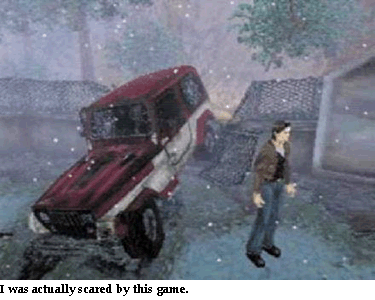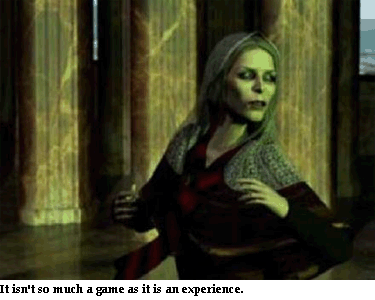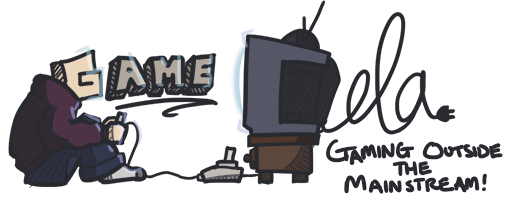When I first picked up this game, I had a very good reason: Resident Evil was super-cool. I was expecting to pop it in and get my survival horror fix. I was looking forward to conserving unreal amounts ammo and health (having myself been conditioned to do so by RE), seeing a cheesy sci-fi/zombie story unfold, and maybe playing a second time to get some cool items. One thing I did not expect to do was to become freaked out enough to turn off my console and leave my house.
Let me start by saying that nothing in the media has ever scared me before since I’ve been old enough to remember, and Resident Evil most certainly didn’t. I never thought in a million years that a videogame could invoke any real fear in me. But Silent Hill did. I can only describe the feeling I got when I first played it by taking the intensity of a roller-coaster and combining it with the instinctive imagination-running-away fear of being in a dark forest alone and hearing whispers all around (you know it’s happened to us all).
About five minutes in, I realized I was NOT in Raccoon City anymore, and that this was not going to be a videogame. It was going to be an experience. In case I haven’t made a clear point yet, let me do so with a simple declarative statement: Silent Hill is very scary. RE has surprising moments, and maybe even some spooky ones. Sometimes the monsters closing in would even cause a tingle on my neck. But I was never truly scared. I was with SH.
Now that the analysis of what makes this game different from RE (and from all previous videogames), I can evaluate it as a videogame.

Silent Hill’s premise is simple. You’ve had a wreck and lost your daughter, and you have to find her and get out of Silent Hill. But things don’t go that well. And they don’t look too promising, either.
Stuck in Silent Hill, things get really weird really fast. You control the protagonist from a changing third-person perspective as he tries to navigate the town and stay alive. You must decipher clues, search buildings, and fight nightmarish creatures as you slowly come closer to the truth behind your situation.
Giving away much more that this would be a sin. Suffice it to say, you end up using weapons and solving puzzles à la Resident Evil, and a city isn’t the only place you’ll visit. Silent Hill’s gameplay is so based on atmosphere and primal fear that you just have to experience it for yourself to see what really makes it a 10.
Necessity is the mother of invention, they say. I did realize right away the fog in this game was to hide the popup problems that would naturally be inherent in a game with an engine like this, and I have heard some negative criticisms of this; but I actually think it contributes a very good deal to the suspense of being chased, the overwhelming sense of being hopelessly lost in a town you don’t know your way around, and just the dark mood in general. Some of the patches used for the wall textures seemed quite low-detail, but this is to be expected of a PlayStation game of its time (and on one disc!). The town and other locales themselves are rendered quite nicely, with realism in its plainness (and a bit of surrealism for those who pay attention), and what is probably the most elaborate detail I have ever seen. The designers also seemed to know what fear “looks” like, as you will see when you travel to some of the occult-inspired settings.
The characters all have decent poly counts and realistic animations, and the monsters’ movements drove me almost insane with creepiness sometimes. Witness the zombie-child slowly come into focus from the darkness, and realize that there are two! See the “eight man” (basically a zombie monkey) leaping behind you—as fast as you—and find yourself tilting the controller forward like you did when you were six years old. Harry (the main character)’s pocket light is also one of the neatest uses of light-sourcing I have ever seen. I wasn’t as impressed with anything similar until Code: Veronica. The characters’ lack of a cinematic level of detail is also made up for with the sparse-but-gorgeous CG cutscenes, and Konami does this as well as, if not much better than, any other game up to its time.
RE’s controls suck because of ____. Fill in this blank, and you’re likely to make a somewhat valid point about the controls of Silent Hill. Also similar, and just as valid, is the argument that the controls can be mastered if you spend time with them. The dramatic and sometimes dynamically shifting camera angles that seem to want to prove to you that a non-static camera can more than make up for the lack of rendered backgrounds can have you cursing the controller at first. (Think RE—you have to remember what direction the character is facing, and push Up to go that way—and add to this a camera that moves, and sometimes even spins as you do.) But this point cannot be considered very valid for at least a couple of reasons: there are very seldom any such camera tricks used in a combat situation, and if you have trouble, the L2 button allows you to switch to a view behind our hero Harry (or a quasi-first-person view if you access the secondary menu options). All in all, I would say that the movement is at least on par with RE‘s.

Another factor that deserves special mention is the vibration function. Although I think the analog stick is crap for this game, the vibration adds one more element of immersion and provides a very special function. You will feel Harry’s heartbeat as his health drops – from the slightest quiver at 5/6ths to a worrisome rumble at 1/6th. This is not, as others have claimed, the only way to judge your health without switching to the menu (pay attention to Harry’s breathing when you stop moving—heavier panting after relatively little running means less health), but it is certainly a good reason to have a DualShock for this game, especially on hard mode and very especially if you want to try for a high score.
The aiming is—well, another story. On some level, this can be understood (Harry is a writer, and we can assume he doesn’t have much experience shooting pterodactyls and the like) and is explained to some degree. However we as gamers are experienced with guns, and for those of us going for a high score, Harry missing a shot at point blank is just unacceptable. You can learn several tricks regarding the glitchy aiming, but there is really little way to get it to do what you want consistently. This is really the only thing about the game I don’t like, and I might have even liked it if it weren’t such a big deal to avoid missing shots for the final tally screen.
The sounds in this game push it along more than you might realize your first time through, because of precisely how big a part of the overall experience they are. All of the sounds are done very well, but never get in the way. You never know when some creepy or surprising ambient sound is waiting in a room, and those of you on blood pressure medication might consider taking an extra dose before getting into some of the darker areas of this game. The sounds of the protagonist and the monsters are also all realistic and mood-setting, and the radio is the icing on the cake.
Harry’s radio, which emits white noise when a monster is near, is probably the biggest element in creating the immediate fear factor. You know there is a monster as you approach it, whether the camera wants to show you or not, and your heart starts pounding in anticipation of the moment of fight-or-flight. (The turquoise babies prove to be the ultimate climax in this system, and left me shivering throughout the game.) The voice acting is so-so, and doesn’t quite reach the same “haha” type of so-so that RE gives us, so you’ll have to try a little harder to be amused by it. The problem here is not worse-than-usual voice talents, but the designers’ decision to have the voices pause mid-sentence to allow the subtitles to catch up. This is a small but forgivable blemish in an otherwise impeccable sonic landscape, and is more than made up for by the game’s music.
Not enough can be said to praise this game’s music. It is such a well-incorporated and large contributing factor to the fear that many may not even notice it, but it is there. In fact, one scene is even based entirely on the music (notice the second sewer scene). I don’t think I can even describe this soundtrack in words. Just as much as Konami knew what fear looked like, they also seemed to know what it sounds like. Much of it is just creepy ambiance. But make no mistake—it is musical, just in a really weird-out kind of way. The music is layered so that different sounds can fade in and out, always appropriate for what they are complimenting, but still maintaining the same beat. Here we see another intensifier of the suspense: the music will get louder and scarier right when there is nothing to be scared of in a room. (This may also be to counteract the fact that you already know there is nothing there because of your radio, or perhaps to make sure you can hear the monsters’ sounds when they are there—another case of necessity bearing invention?)
The developers also knew when silence was golden, and contrasted it with the fast, chase-scene type of stuff. This can really get your pulse pounding and keep you on your toes. Tracks like the percussion-driven “nurse attack” just can’t be matched by anything in RE, and I think it’s twice as scary as what an orchestra could produce. When the game finally gives in and plays “real” music (mainly in the opening/ending cinemas), we hear unbelievably well-produced, high-quality tunes that lean toward some acoustic guitar rock, well fitting the old-time feel of the cinematic theme, and complete with the popping of the records. Let me get this over with: this game’s music does as good a job complimenting the game as any has ever done. Assuming that this is the purpose, I will call it perfect. Stand it alone, and maybe it’s not what you’d play in your car or dance to, but it serves its purpose flawlessly.
Silent Hill is a real experience—different from normal gaming. In this aspect I consider it similar to Shenmue in that it breaks ground in its field. It’s fun, and it will scare you. I am a big fan—after attaining the near-impossible 10 stars, I decided to reserve this game for every Halloween, and I play it alone and in the dark, like a ritual.

But it is also a videogame, and it is a fun one. This is the first non-RPG game I have ever really mastered. Other games have been fun, but after the ending credits, it was over for me. But there is something addictive about SH (White Claudia, anyone?), and the replay value is there to back it up. Not only is there the star ranking system to test your speedrunning and monster-slaying skills, there are many cool secret items, five distinctly different endings, and enough chills to keep you up for weeks (I have been through this game 19 times, according to my memory card).
If you think you are immune to scary media, this game is for you. If you like scary stuff, this game is for you. If you are just into videogames and don’t like to be scared—well, it’s a great and groundbreaking game, so just play it during the day with the lights on and someone sitting next to you.
